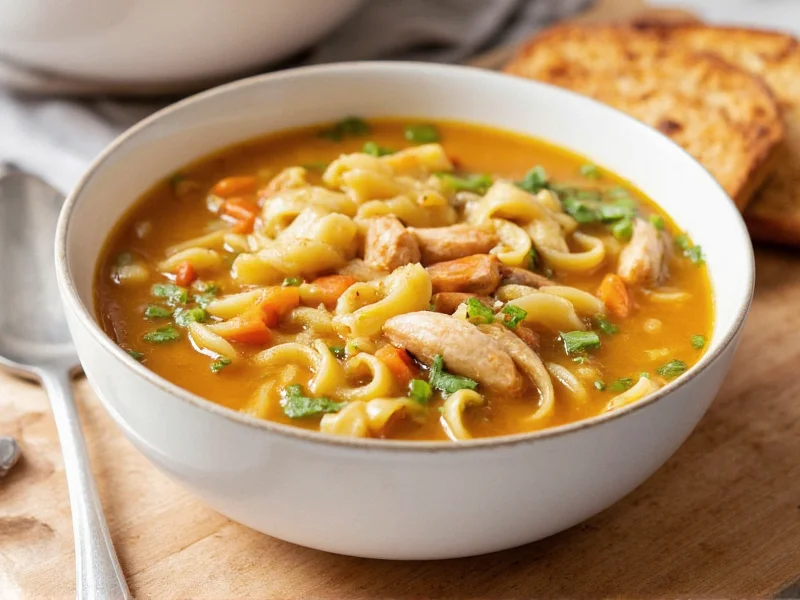Understanding Progresso Chicken Noodle Soup Varieties
Progresso offers several versions of their classic chicken noodle soup, each designed to meet different consumer preferences. The standard Progresso Chicken Noodle Soup has been a pantry staple since the brand's introduction in 1969. Unlike many competitors, Progresso uses real chicken meat rather than chicken broth concentrate as the primary protein source. The homestyle variety distinguishes itself with larger chicken chunks and wider egg noodles, creating a more substantial eating experience.
Nutritional Profile Analysis
When evaluating Progresso chicken noodle soup nutrition facts, it's important to understand the complete nutritional picture. While convenient and comforting, canned soups often contain higher sodium levels than homemade versions. The standard variety contains significant sodium content, which consumers with dietary restrictions should consider.
| Nutrient | Standard Variety (per 1 cup) | Low Sodium Variety (per 1 cup) | Homestyle Variety (per 1 cup) |
|---|---|---|---|
| Calories | 80 | 70 | 90 |
| Total Fat | 2.5g | 2g | 3g |
| Sodium | 890mg (37% DV) | 280mg (12% DV) | 900mg (38% DV) |
| Protein | 3g | 3g | 4g |
| Carbohydrates | 13g | 12g | 14g |
Ingredient Breakdown
Examining Progresso chicken noodle soup ingredients reveals a straightforward formulation. The standard version lists chicken, broth, egg noodles, carrots, celery, and seasonings as primary components. Unlike some budget brands, Progresso avoids artificial flavors and colors in their traditional recipe. The homestyle chicken noodle soup ingredients include larger vegetable pieces and more substantial chicken portions, contributing to its premium positioning.
Food scientists note that the soup's texture stability comes from modified food starch, which prevents the noodles from becoming overly soft during storage. The chicken pieces maintain their integrity through a careful cooking and canning process that preserves protein structure.
Comparing Progresso Varieties
Consumers often wonder about progresso homestyle chicken noodle soup vs regular differences. The homestyle version contains approximately 10% more chicken by weight and uses wider egg noodles that hold their shape better when reheated. The broth in the homestyle variety has a slightly richer flavor profile due to additional vegetable extracts.
For those monitoring sodium intake, the progresso low sodium chicken noodle soup reduces sodium content by about 65% compared to the regular version while maintaining similar flavor through a proprietary seasoning blend. This makes it a better option for individuals following heart-healthy diets.
Practical Usage Tips
Professional chefs recommend several techniques to enhance store-bought soups. To improve progresso chicken noodle soup taste, try adding fresh herbs like parsley or thyme during the last minute of heating. For a more substantial meal, incorporate additional vegetables such as diced zucchini or spinach. Many home cooks find that a squeeze of fresh lemon juice just before serving brightens the overall flavor profile.
When preparing progresso chicken noodle soup recipe ideas for family meals, consider using the soup as a base for casseroles or pot pies. The consistent texture and flavor make it an excellent starting point for more elaborate dishes. For those seeking to reduce sodium further, diluting the soup with additional water or low-sodium broth can help adjust to personal taste preferences.
Storage and Safety Information
Understanding progresso chicken noodle soup shelf life is essential for food safety. Unopened cans maintain quality for 18-24 months when stored in a cool, dry place. Once opened, transfer unused portions to an airtight container and refrigerate for up to 3-4 days. Never leave prepared soup at room temperature for more than two hours.
Food safety experts recommend checking for signs of spoilage before consumption, including bulging cans, off odors, or unusual discoloration. The USDA advises against consuming canned goods from dented or damaged containers, as these may compromise the product's safety.
Frequently Asked Questions
Does Progresso chicken noodle soup contain real chicken?
Yes, Progresso chicken noodle soup contains real chicken meat as the primary protein source. The standard variety lists chicken as the second ingredient after broth, while the homestyle version contains larger, more visible chicken pieces. The company specifies that they use white meat chicken in their formulations.
How can I reduce the sodium content in Progresso chicken noodle soup?
To reduce sodium in Progresso chicken noodle soup, consider using the low-sodium variety which contains about 65% less sodium than the regular version. Alternatively, dilute regular soup with additional water or low-sodium broth. Adding fresh vegetables can also help balance the flavor without increasing sodium content. Many home cooks find that a splash of lemon juice or vinegar enhances flavor perception without adding salt.
What's the difference between Progresso homestyle and regular chicken noodle soup?
Progresso homestyle chicken noodle soup contains larger chicken pieces, wider egg noodles, and a slightly richer broth compared to the regular variety. The homestyle version has approximately 10% more chicken by weight and features more substantial vegetable pieces. Nutritionally, the homestyle variety contains slightly more calories and sodium per serving due to the increased ingredient density.
Can I freeze Progresso chicken noodle soup?
Yes, you can freeze Progresso chicken noodle soup, but the texture may change when thawed. Egg noodles tend to become softer after freezing and reheating. For best results, freeze the soup in airtight containers with about one inch of headspace for expansion. Consume frozen soup within 2-3 months for optimal quality. Thaw in the refrigerator overnight before reheating gently on the stove.
How long does opened Progresso chicken noodle soup last in the refrigerator?
Once opened, Progresso chicken noodle soup remains safe to eat for 3-4 days when properly stored in an airtight container in the refrigerator at or below 40°F (4°C). Always check for signs of spoilage before consuming, including off odors, unusual texture, or visible mold. Never leave opened soup at room temperature for more than two hours, as this falls within the food safety danger zone where bacteria multiply rapidly.











 浙公网安备
33010002000092号
浙公网安备
33010002000092号 浙B2-20120091-4
浙B2-20120091-4